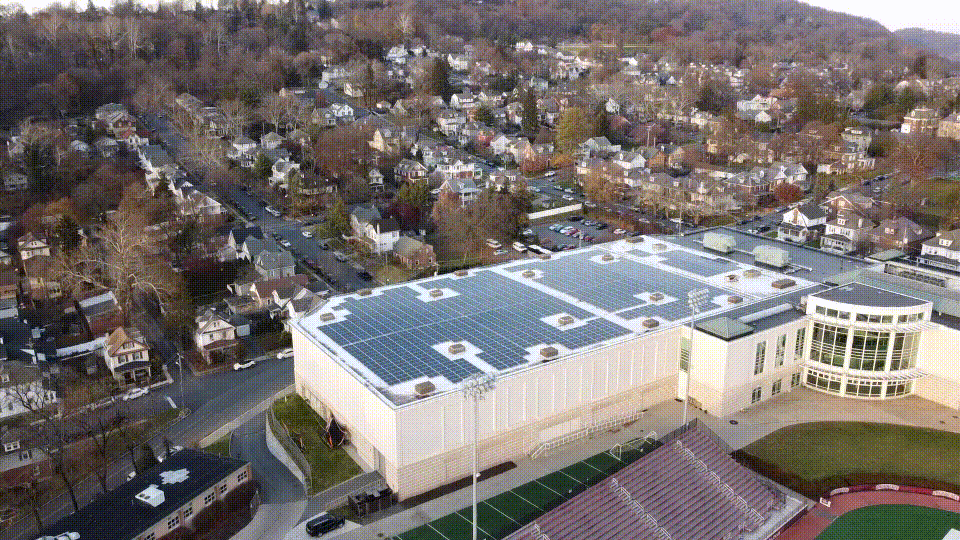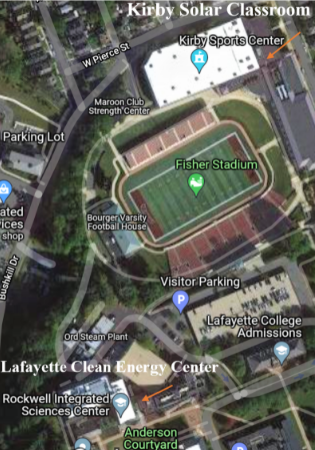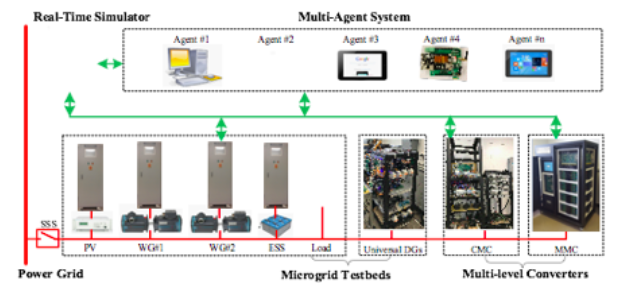
Drone videography by Matthew Bahr
Technical
To create such an organization on campus, there are many technical aspects that are required by both Lafayette College as well as other organizations within and outside of campus. Creating an organization such as what we aim to create at Lafayette takes a significant amount of planning around a vast number of students and faculty, all of which need to be accounted for. In order to successfully orchestrate the creation of the clean energy center, we have put together a proposal outlining key aspects of the center as well as how we can solve the challenges that arise.
Overall Mission
The overall focus of the Lafayette Clean Energy Center is to establish an organization on campus that can act as the center of renewable energy technology on campus, and provide a learning environment and database for all Lafayette students to involve themselves in clean energy and the environment. To do so, the Lafayette Clean Energy Center will act as the main hub for students and faculty, providing students the opportunity to work more directly in all aspects of this field. The main mission of the Center can be categorized into multiple goals: to coordinate and host renewable energy-related events and programs, to act as a resourceful energy database, and lastly to act as a clean energy laboratory within Lafayette’s curriculum. The Clean Energy Center can promote green energy on campus and involve much of the student body within clean energy related events such as solar competitions, as well as bring in students from multiple disciplines to work hands-on within solar energy data and equipment. Another crucial aspect of the Lafayette Clean Energy Center would be the creation and use of the Kirby Solar Laboratory, a faculty operated classroom for students to participate and learn directly from an active solar array. Involving a broad number of students and courses within the Lab would not only deepen the curriculum at Lafayette, but can also act as a foundation for younger engineering students to develop a passion and interest for clean energy. Lastly, to provide even more resources for Lafayette, the Clean Energy Center would act as a clean energy database for students and faculty to access freely. This can provide students with more information or data relating to solar energy production, credits, and many other important datasets to involve within their studies. The Center’s mission is to provide students with the ability, resources, and information needed to involve themselves within renewable energies in order to promote their adoption both on and off campus.
Curricular Involvement
One of the Clean Energy Center’s biggest objectives is to involve the Kirby Solar Array and other aspects of renewable energy within the curriculum of Lafayette students. The goal is to involve as many different people, backgrounds, and courses directly within the Center to learn and contribute to the development of clean energy on our campus. To do so, the Center provides the data, laboratory, and faculty for students to deepen their learning in regards to renewable energies. Classes endorsed by the Center can be held within our locations, providing courses of all majors and minors for students to be able to have an excellent learning experience from the Solar Array at Lafayette. This curricular involvement can help promote discussion of the environment and sustainability throughout campus, and involve more people within the sociotechnical aspects of renewable energies.
While the Clean Energy Center looks to involve all students within the field of renewable energy, we aim to put an emphasis on involvement within incoming Engineering Studies students. As a relatively small major that is mainly filled late in a student’s academic career, early involvement from first year students within the major would be extremely beneficial to this department. To involve these younger students, we plan on working with another group of Engineering Studies students who are looking to implement a First Year Seminar aimed specifically involving the solar array. Their proposed FYS is aimed at engineering-minded students and can be an amazing opportunity to involve students within a sociotechnical engineering setting while also giving them a greater introduction to renewable energy and sustainability. To involve this specific course, the Clean Energy Center can provide the means to host lectures or events to involve students within the Center, as well as provide deeper learning sources. The Center can get these young students involved within the goals and ideals of the center, while also providing them hands-on experience and knowledge. The Kirby Solar Lab can be an amazing opportunity to show FYS students a non-classroom technical learning environment while simultaneously involving energy related data in their coursework. The establishment of the Clean Energy Center not only benefits the students and campus at Lafayette, but also supports the development and growth of existing majors.
Another advantage of the Clean Energy Center is the ability to provide the array database to students and faculty from any educational department.. Through this development, other science and engineering faculty will have easy access to develop projects and course material around students using the data from the Kirby Solar array. Another potential use for the solar array in coursework could be the development of economic analysis surrounding solar installation in engineering studies courses or economics courses. One particular course that would be easy to integrate the array would be the engineering economics course that is required for engineering studies students in which students can perform various financial analysis on the Kirby array as well as other solar arrays to learn about the cost saving potential of renewable energy systems.
Aside from coursework and student engagement, another benefit of the Kirby Solar array could be the development of community engagement programs to strengthen the relationship between Lafayette College and the Easton community. For a template for this our group chose to look at the Drexel University case study and some of the community initiatives they have already developed. One of the easier initiatives to implement, we believe, would be a solar competition similar to that of the “Junior Solar Sprint” competition that is run by Drexel and the Philadelphia Solar Energy Association. In order to put on a competition such as this it is likely the College would need to partner with local schools as well as a local company or organization to sponsor the event. One advantage Lafayette would have to hosting the event is that it could be run in the Kirby Sports center which the claim could then be made that is “powered entirely by solar energy generated from the solar array on the roof.” This combination of the competition along with the point that can be made to the students about a practical application of solar power will provide a strong exposure to local students on the usefulness of solar energy. In addition to this exposure, the college can also strengthen its ties with the local community and strengthen its public image. Currently, a program is run where students from the Intro to Environmental Engineering class work on a lab activity with students from Cheston and Paxinosa elementary schools. This same framework can likely be applied to this competition and allow for students to interact with the local students building solar powered cars.
Community Support
Aside from being a place for the community to involve themselves with renewable energies and the environment, we envision using the Clean Energy Center as a database and resource center for students and faculty looking to research or work with the Kirby Solar array. We hope to make data and information about the array available at the Clean Energy Center, as well as on the energy center’s website. For example, we want to be able to create and make available a database of renewable energy credits or incentive programs offered in the Easton area that can be made available to students, faculty, and the public. This will allow students and faculty to use data from the solar array and from the incentive database for research or other academic purposes. And by making a renewable energy incentive resource available to the Easton community, Lafayette can play an important role in helping to increase solar energy adoption in our local community and increasing the community connection between Lafayette College and the Easton community. Lafayette could provide an invaluable resource to residents in the form of hyper-local economic data for solar arrays, on top of using the college’s experience to help guide residents through the complex government incentive programs.
Space
A big challenge that comes to our attention is the topic of space and location. In order to have the Lafayette Clean Energy Center, there needs to be a designated location or office in which the faculty and students can work and involve themselves. The purpose of the Clean Energy Center is to involve people from all over campus within clean energy systems, so a space to house all said activities is crucial to the development of the Center. In order to reduce materials, costs, and labor, we thought it would be best to take advantage of the buildings we already have built on campus to house the Center. Also, in order to have the opportunity for students and faculty to involve themselves hands-on with the Kirby Solar Array, the Clean Energy Center needs the ability to access the Kirby Solar Array directly. Additionally, having a physical space that students and visitors can see is important for increasing visibility of the Kirby Solar array and reinforcing the college’s sustainable image.
When deciding on a space for the Clean Energy Center, we wanted students to have both a community centered office as well as a hands-on learning environment. In order to achieve both, our group made the decision to propose the establishment of the Clean Energy Center within Rockwell Integrated Science Center, as well as establishing the Kirby Solar Lab within the Kirby Sports Center. The Clean Energy Center would involve an adequately sized meeting room that would be able to house community meetings, as well as desks for faculty and student interns. Additionally, this is ideally where we would house the main data and resource and center by dedicating a section of the office for computerized research and analysis. RISC is beyond ideal to house the Center, because not only is it a curricularly involved science building, but it also allows for greater involvement and collaboration with the Office of Sustainability which is also located in RISC. The Sustainability Office would have an influential and direct relationship with the Clean Energy Center, and having the main offices be within the same building would be extremely beneficial. This building also houses the Dyer Center for Innovation and Entrepreneurship, which is another organization on campus that could collaborate with the Clean Energy Center. Lastly, RISC is a very popular building on campus, housing many study spaces as well as the EcoCafe. This can bring more foot traffic and student involvement to the Center, which is beneficial due to the interdisciplinary nature of the Center. Having the Clean Energy Center in RISC would provide students and faculty with an ideal working environment, while also incorporating all aspects of community life on campus.
In order to provide deeper, more hands-on involvement within renewable energies, the Lafayette Clean Energy Center would involve the Kirby Solar Lab for further renewable energy education at Lafayette. In order to establish this active learning laboratory, we propose repurposing one of the many rooms in the Kirby Sports Center into a lab where students can directly study aspects of our solar array such as solar outputs and other metrics, as well as perform hands-on projects with the solar panels. This space can be used to apply Lafayette’s solar array within multiple different disciplines, introducing more people to renewable energies. Although having multiple locations on campus can be quite complicated, we think that Lafayette can seamlessly integrate both locations based on the size of Lafayette’s campus. Pictured in Figure 8 below, Lafayette’s campus is easily walkable, making the interactions between the two locations much easier than normal. While supplementing the Clean Energy Center with solar involvement and data, the Kirby Solar Lab can seamlessly provide an amazing opportunity for students of all disciplines to involve their studies within renewable energy technologies.

Figure 8: Map of RISC and Kirby Sports Center
In order to model what we will need for this lab we examined a similar project at the Lehigh University Smart Microgrid and Renewable Technology Lab or SMRT. A subset of the Lehigh Energy Research Center, the Smart Microgrid and Renewable Technology lab allows students to test and study energy output around four different types of substations in a microgrid test bed (Lehigh University, n.d.). A microgrid, most simply put, is “a local energy grid with control capability, which means it can disconnect from the traditional grid and operate autonomously (Department of Energy, 2014).” Since the array has already been constructed, students can use similar technologies to those used at the SMRT lab to analyze the energy output of the solar array. In order to construct this lab, the following materials below will be needed (See Figure 9).

Figure 9: Technological Diagram from the Lehigh SMRT Lab
Faculty
With our designated locations in place, the second technical challenge that we face is interviewing and hiring the potential faculty members who will organize and operate the Clean Energy Center, as well as the Kirby Solar Lab. While the Clean Energy Center will be heavily student involved, more knowledgeable and experienced faculty would be necessary to ensure the success and effectiveness of the Center. Of the faculty positions involved, we propose two new positions within the Lafayette Clean Energy Center. First, we propose a Clean Energy Center Executive Director, who will lead and facilitate all overarching operations within the Center. This position is the most important within the Center, and would supervise and manage all events and processes held by the Clean Energy Center. This involves many activities from a range of energy related disciplines, whether technical energy applications or community involvement. Since this is such a crucial and intricate position, some of the criteria we propose involve significant experience within the energy or renewable energy fields, as well as being dedicated, passionate, and highly involved with students. It would be this position’s responsibility to ensure the school gets the most benefit from the LCEC, and that it’s resources are available to as many community members as possible.
The second position we would like to propose would be the Clean Energy Center Lab Manager. This position would mainly be responsible for the Kirby Solar Lab and all activities associated within. This position would be less involved within the Clean Energy Center programs themselves, but would have a significant responsibility within the living laboratory aspects of the Center. This involves the maintenance and upkeep of the Solar Lab and the materials within, ensuring that all technologies and processes run smoothly. While this position requires a similar amount of experience within the renewable energy field as the Director, a larger focus on technical or laboratory work related to clean energy would be highly critical. This position needs to understand the whole workings of solar technologies, as well as being able to illustrate those processes to a wide range of students. Because this lab is mainly student based, this position involves the oversight of students from all disciplines, as well as working collaboratively with other professors to help connect their students’ curriculum to the solar array. Lastly, this position helps bridge the gap between the two locations involved, and ensure the solar information and energy programs are being relayed effectively.
Because of the Center’s interconnected relationship with the Office of Sustainability, we can also involve them for references or recommendations in reference to potential faculty. Just like the Sustainability Office, the Clean Energy Center would be heavily involved within student internships, giving students the responsibility to run different aspects of the organization. With that being said, Delicia Nahman’s understanding of the power dynamics within a process like this could be beneficial within the hiring process. Overall, the Sustainability Office should have a significant say within hiring faculty, based on how often these offices and faculty will be interacting.
In order to establish a center on campus dedicated to clean energy, there are many technical and organizational challenges that have to be addressed not only by Lafayette, but also by the community. To establish the Lafayette Clean Energy Center, the school would need a large proposal, outlining the benefits, costs, and logistics surrounding the creation of such an organization. The process would involve crucial collaboration with the Office of Sustainability, as well as other organizations and faculty.